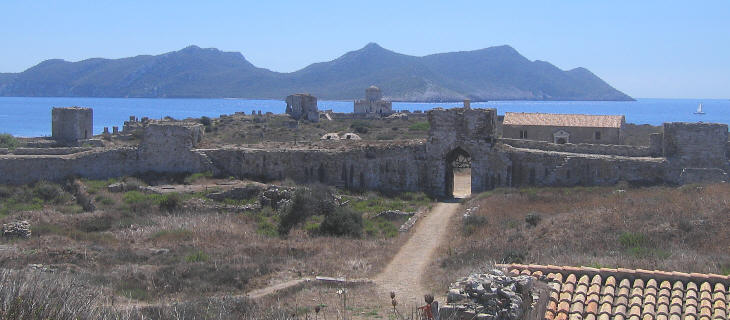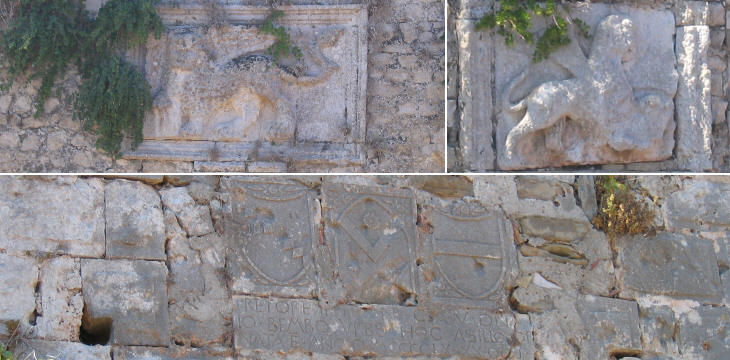  What's New! Detailed Sitemap All images © by Roberto Piperno, owner of the domain. Write to romapip@quipo.it. Text edited by Rosamie Moore. Page revised in November 2007. |
  Modon (Methoni) Modon (Methoni)
Key dates: 1125 Venetians occupy Modon. 1500 Sultan Bayazet II invades Peloponnese and forces Venetians out of Modon. 1686 Venetians return to Modon. 1714 Second occupation by the Turks. Maritime routes in the Mediterranean closely followed the coastline. This made Modon, a small harbour at the tip of the western Peloponnese peninsula, across from the Island named Sapienza (Wisdom), a strategic point on the route from the Ionian to the Aegean Sea, a key section of the route from Italy to the eastern Mediterranean. For this reason Modon and the nearby fortress of Corone were called the "eyes of Venice".
In particular Modon was key to a very profitable business: the pilgrimage to Jerusalem. The pilgrims embarked at Venice for Palestine on regularly scheduled sailings, June through September to take advantage of the northwest wind. From 1227 on, the Venetian government controlled the pilgrim business: ships could not be overloaded, and the captain was obliged to take pilgrims where they wanted to go and not to engage in trading along or off the route unless agreed upon in the contract. In the course of seven weeks they could sail along the coast of Istria and Dalmatia, through the Ionian Islands, stopping at Modon, then on to Cerigo (Kythira), Candia (Crete), Rhodes, Cyprus, and finally Jaffa. After visiting Palestine the pilgrims would often journey overland to the monastery of St. Catherine on Sinai and then to Egypt, whence they would sail from Alexandria back to Venice.
What follows is an account written by Felix Fabri, a pilgrim in 1483. He stopped in Modon, before he and his fellow pilgrims continued on to Crete (source: Felix Fabri, "The Wanderings of Felix Fabri," vol. 7 of The Library of the Palestine Pilgrims' Text Society, 1887-1897, p 184-186). "On the fifteenth [of June, 1483], which was the third Sunday after Trinity, and the feast of St. Vitus and St. Modestus, when the sun rose, the galley-slaves begun to work the galley along with their oars, because the wind was not fair for the harbour of Metona [Modon], from which we were not more than one German mile distant. By great labour we got into it about eight o'clock in the forenoon". Fabri and his companions tour the Venetian city of Modon: "Straight[a]way we got into the boat and rowed to the city, where we found the pilgrims who sailed with Master Augustine [in the second, rival Venetian pilgrim galley bound for the Holy Land]. I took my lords and some other pilgrims to the church of the Preaching Friars, and there we heard high Mass. The prior of that place and the other brethren knew me well from my first pilgrimage [in 1481]. After Mass was over we went to the house of the bakers, where biscuits are baked for seafarers, wherein dwells an old German, and there we had our dinner cooked, and dined. The other pilgrims went over to the house of the Teutonic Knights and there provided a meal for themselves. After dinner we went up to the walls of the town and walked round upon them, and admired its impregnable fortifications. It is not an island, but part of the mainland [a peninsula], whereof the whole [of the rest of the mainland] belongs to the Turks. In this port lay also the galley of Master Augustine, and all his pilgrims were in the city, so we made a happy and merry fellowship with them, though this displeased the captains, who thought that because they had quarrelled and were at enmity one with another, even so we ought to be tainted with the same venom, and ought to avoid each other's company. But we took no heed of this, and both ate and drank together with them, and we brought them on board and showed them our galley, and they took us to see theirs, and so we spent the day together until vespers, rejoicing with each other at having met in the middle of the sea; for the city of Modon is said to be midway between Venice and Jerusalem. About vespers both patrons blew their horns to call their pilgrims on board, and when we heard this signal we all went on board the galleys. That same evening Augustine and his pilgrims left the port, but we remained there until the morrow."
Another pilgrim, Pietro Casola, made his journey to Jerusalem in 1494. Unlike most other chroniclers of the pilgrim experience, he did not let his piety stifle an inquisitive and observant nature. Sailing at night between Zante and Modon, he provides us with just the sort of account otherwise lacking in the literature: "All complained of the extreme heat except the Germans and certain other nations, who - said the venerable Don Francesco in his sermon - ate and drunk from morning till night and then went supper less to bed. These individuals did not feel the heat; the rest of us did unfortunately. And thus ended the day of St. John the Baptist. At length by the grace of God, we arrived at Modone at the twentieth hour, and all landed in great haste, without waiting for the casting of the anchor, so great was the desire to go on land. Although, in truth, there was not much comfort in the way of lodgings to be found there…it was as much as we could do to find a few eggs. He notes some further details about the town of Modon, and then: There is a large suburb, also walled. It seems to me that the greater part of silk industry is carried on in the said suburb; certainly many Jews, both men and women, live there, who work in silk".
The walled suburb mentioned by Pietro Casola was the vast area between the medieval fortifications and the sea: these were made up of a simple curtain of wall with square towers placed at regular intervals.
In 1460 the Venetians built new walls which could withstand artillery fire and a large quadrilateral bastion named Bembo after the town governor. They also built walls which reached the sea and included the market square.
The Venetians placed a (lost) statue portraying the Lion of St. Mark on a granite column they found in a shipwreck near Cerigo: according to a barely visible inscription it was placed there in 1493; other symbols of the Republic were placed on public buildings and on the walls: some of them are still where the Venetians placed them, others were relocated by the Ottomans when they modified parts of the fortress.
The Venetians fortified with a large tower (Castel da Mar) the access from the sea and built a second tower on a rock immediately outside it: (this is named with the Turkish word Bourtzi). Both buildings were strengthened during the Ottoman period and a stone with the coat of arms of the Venetian governor ended up at the foot of the Sea Gate wall. During the second Venetian occupation (1686-1714) a new large bastion (Bastione Loredan) was completed and a 1714 inscription celebrated the event: notwithstanding this a few months later the garrison surrendered without fighting.
Excerpts from Memorie Istoriografiche del Regno della Morea Riacquistato dall'armi della Sereniss. Repubblica di Venezia printed in Venice in 1692 and related to this page:
Introductory page on the Venetian Fortresses Pages of this section: On the Ionian Islands: Corfù (Kerkyra) Paxo (Paxi) Santa Maura (Lefkadas) Cefalonia (Kephallonia) Asso (Assos) Itaca (Ithaki) Zante (Zachintos) Cerigo (Kythera) On the mainland: Butrinto (Butrint) Parga Preveza and Azio (Aktion) Vonizza (Vonitsa) Lepanto (Nafpaktos) Atene (Athens) On Morea: Castel di Morea (Rio), Castel di Rumelia (Antirio) and Patrasso (Patra) Castel Tornese (Hlemoutsi) and Glarenza Navarino (Pilo) and Calamata Modon (Methoni) Corone (Koroni) Braccio di Maina, Zarnata, Passavà and Chielefà Mistrà Corinto (Korinthos) Argo (Argos) Napoli di Romania (Nafplio) Malvasia (Monemvassia) On the Aegean Sea: Negroponte (Chalki) Castelrosso (Karistos) Oreo Lemno (Limnos) Schiatto (Skiathos) Scopello (Skopelos) Alonisso Schiro (Skyros) Andro (Andros) Tino (Tinos) Micono (Mykonos) Siro (Syros) Egina (Aegina) Spezzia (Spetse) Paris (Paros) Antiparis (Andiparos) Nasso (Naxos) Serifo (Serifos) Sifno (Syphnos) Milo (Milos) Argentiera (Kimolos) Santorino (Thira) Folegandro (Folegandros) Stampalia (Astipalea) Candia (Kriti) You may refresh your knowledge of the history of Venice in the Levant by reading an abstract from the History of Venice by Thomas Salmon, published in 1754. The Italian text is accompanied by an English summary. Clickable Map of the Ionian and Aegean Seas with links to the Venetian fortresses and to other locations (opens in a separate window) |







